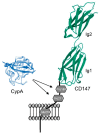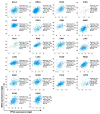Cyclophilin A/CD147 Interaction: A Promising Target for Anticancer Therapy
- PMID: 36012604
- PMCID: PMC9408992
- DOI: 10.3390/ijms23169341
Cyclophilin A/CD147 Interaction: A Promising Target for Anticancer Therapy
Abstract
Cyclophilin A (CypA), which has peptidyl-prolyl cis-trans isomerase (PPIase) activity, regulates multiple functions of cells by binding to its extracellular receptor CD147. The CypA/CD147 interaction plays a crucial role in the progression of several diseases, including inflammatory diseases, coronavirus infection, and cancer, by activating CD147-mediated intracellular downstream signaling pathways. Many studies have identified CypA and CD147 as potential therapeutic targets for cancer. Their overexpression promotes growth, metastasis, therapeutic resistance, and the stem-like properties of cancer cells and is related to the poor prognosis of patients with cancer. This review aims to understand the biology and interaction of CypA and CD147 and to review the roles of the CypA/CD147 interaction in cancer pathology and the therapeutic potential of targeting the CypA/CD147 axis. To validate the clinical significance of the CypA/CD147 interaction, we analyzed the expression levels of PPIA and BSG genes encoding CypA and CD147, respectively, in a wide range of tumor types using The Cancer Genome Atlas (TCGA) database. We observed a significant association between PPIA/BSG overexpression and poor prognosis, such as a low survival rate and high cancer stage, in several tumor types. Furthermore, the expression of PPIA and BSG was positively correlated in many cancers. Therefore, this review supports the hypothesis that targeting the CypA/CD147 interaction may improve treatment outcomes for patients with cancer.
Keywords: BSG; CD147; PPIA; anticancer therapy; cyclophilin A.
Conflict of interest statement
The authors declare no conflict of interest.
Figures










Similar articles
-
Cyclophilin A (CyPA) induces chemotaxis independent of its peptidylprolyl cis-trans isomerase activity: direct binding between CyPA and the ectodomain of CD147.J Biol Chem. 2011 Mar 11;286(10):8197-8203. doi: 10.1074/jbc.C110.181347. Epub 2011 Jan 18. J Biol Chem. 2011. PMID: 21245143 Free PMC article.
-
CD147-Cyclophilin a Interactions Promote Proliferation and Survival of Cutaneous T-Cell Lymphoma.Int J Mol Sci. 2021 Jul 23;22(15):7889. doi: 10.3390/ijms22157889. Int J Mol Sci. 2021. PMID: 34360654 Free PMC article.
-
Cyclophilin A: promising target in cancer therapy.Cancer Biol Ther. 2024 Dec 31;25(1):2425127. doi: 10.1080/15384047.2024.2425127. Epub 2024 Nov 8. Cancer Biol Ther. 2024. PMID: 39513594 Free PMC article. Review.
-
Cyclophilin A Inhibitors Suppress Proliferation and Induce Apoptosis of MKN45 Gastric Cancer Stem-like Cells by Regulating CypA/CD147-Mediated Signaling Pathway.Int J Mol Sci. 2023 Mar 1;24(5):4734. doi: 10.3390/ijms24054734. Int J Mol Sci. 2023. PMID: 36902161 Free PMC article.
-
The roles of CyPA and CD147 in cardiac remodelling.Exp Mol Pathol. 2018 Jun;104(3):222-226. doi: 10.1016/j.yexmp.2018.05.001. Epub 2018 May 14. Exp Mol Pathol. 2018. PMID: 29772453 Review.
Cited by
-
Serum EMMPRIN/CD147 promotes the lung pre-metastatic niche in a D2A1 mammary carcinoma mouse model.Front Immunol. 2025 Apr 30;16:1568578. doi: 10.3389/fimmu.2025.1568578. eCollection 2025. Front Immunol. 2025. PMID: 40370456 Free PMC article.
-
Single-Cell RNA Sequencing Reveals the Critical Role of SEC16B in Lung Metastasis of Osteosarcoma.FASEB Bioadv. 2025 Jul 28;7(8):e70025. doi: 10.1096/fba.2024-00161. eCollection 2025 Aug. FASEB Bioadv. 2025. PMID: 40735296 Free PMC article.
-
Integrating genomic profiling to clinical data: assessing the impact of CD147 expression on plaque stability.Front Cardiovasc Med. 2024 Sep 13;11:1425817. doi: 10.3389/fcvm.2024.1425817. eCollection 2024. Front Cardiovasc Med. 2024. PMID: 39355350 Free PMC article.
-
Cyclophilin A: An Independent Prognostic Factor for Survival in Patients with Metastatic Colorectal Cancer Treated with Bevacizumab and Chemotherapy.Cancers (Basel). 2024 Jan 16;16(2):385. doi: 10.3390/cancers16020385. Cancers (Basel). 2024. PMID: 38254874 Free PMC article.
-
Flotillin-2 dampens T cell antigen sensitivity and functionality.JCI Insight. 2024 Dec 20;9(24):e182328. doi: 10.1172/jci.insight.182328. JCI Insight. 2024. PMID: 39499901 Free PMC article.
References
-
- Siegel R.L., Miller K.D., Fuchs H.E., Jemal A. Cancer statistics, 2022. CA Cancer J. Clin. 2022;72:7–33. - PubMed
-
- Batlle E., Clevers H. Cancer stem cells revisited. Nat. Med. 2017;23:1124–1134. - PubMed
-
- Reya T., Morrison S.J., Clarke M.F., Weissman I.L. Stem cells, cancer, and cancer stem cells. Nature. 2001;414:105–111. - PubMed
Publication types
MeSH terms
Substances
Grants and funding
LinkOut - more resources
Full Text Sources
Medical
Miscellaneous

